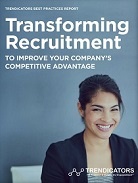
While it’s true that customers who are treated well and have a great experience will continue to come back and spend more, it’s also true that behind every positive customer experience is a dedicated employee.
Every interaction your customer has with your brand rests on the commitment of your employees to serve customers well. However, we are in a time where workers no longer feel the loyalty to an employer that previous generations did. And we continue to see people switch jobs after a year or less because talented workers don’t feel the need to stay in a job they don’t love.
That's why the employee experience is so important. From the moment a person has an interest (seeking a job) with your organization to their first day and beyond, the interactions they have shape and mold how engaged they will be and whether or not they decide to look for greener pastures.
Create Teams of Employees Who Want to Come to Work
Companies strive to have teams of people who love their jobs and want to come to work. On the flip side, employees want a job where they feel valued, and are doing something meaningful. It’s up to the employer to show their employees how and why their roles fit into a larger mission – the basis of engagement.
No matter where people fall in the employment life cycle, positive workplace experiences share these five elements:
Recognition – Recognition reinforces the culture you want to create in your organization and promotes the behaviors that support that culture. Recognition programs promote active, regular recognition using awards, incentives and sometimes competition. But recognition must also involve one-on-one interactions with managers and executives. Personalizing these types of recognition can strengthen the employee experience as you recognize the unique strengths of each team member.
Communication – Employees repeatedly emphasize communication as an important factor in their decisions about a job. Candidates may choose not to take a job if communication is poor during the application and interview stage, and employeSes may not stay with a company if communication styles are ineffective or infrequent. The good news is that communication is easier now than ever, thanks to tools like automated emails, chatbots and mobile alerts. Still, personalized communication is not a thing of the past. Picking up the phone and calling a candidate or sending a handwritten note to an employee still makes a deep impression, especially since fewer companies make an effort.
Personalization – Personalized marketing has become the Holy Grail for building customer loyalty and relationships and for good reason. People respond better to ads that feature products and services they need or want. Not surprisingly, the same thing is true in the workforce. You can build a more loyal, engaged workforce by personalizing rewards, opportunities and interactions to the candidate’s or employee’s preferences.
Purpose – Most employees will say they value meaningful work, but each generation has a different definition of what that means to them. These generational differences in approach can leave team members thinking that others don’t work as hard or care about the company as much as they do. Managers can help resolve these issues by taking into consideration what individuals see as important, and communicating how each role supports the company mission, creating a culture of communication and emphasizing individual strengths.
Investment – Learning development (this includes managers and leaders), education reimbursement programs, mentorships, career coaching and regular meetings make positive investments in your team members. The underlying goal of these initiatives is to support employees in their professional growth, which is one of the top things millennials (and other generations) are looking for in a job.
Put People First
Creating meaningful employee experiences is more than a top-down cultural directive, or a responsibility delegated to direct supervisors. It’s a driving philosophy that flows through every interaction from the moment a candidate applies through to the exit survey. Treating employees and candidates as people will set you apart as an employer of choice – and that’s vital to hiring and retention in today’s volatile talent climate.
Author's Note: This article is an updated version of our 2019 blog, From Pre-Hire to Retirement: Employee Experiences that Engage and Retain at Every Stage.


